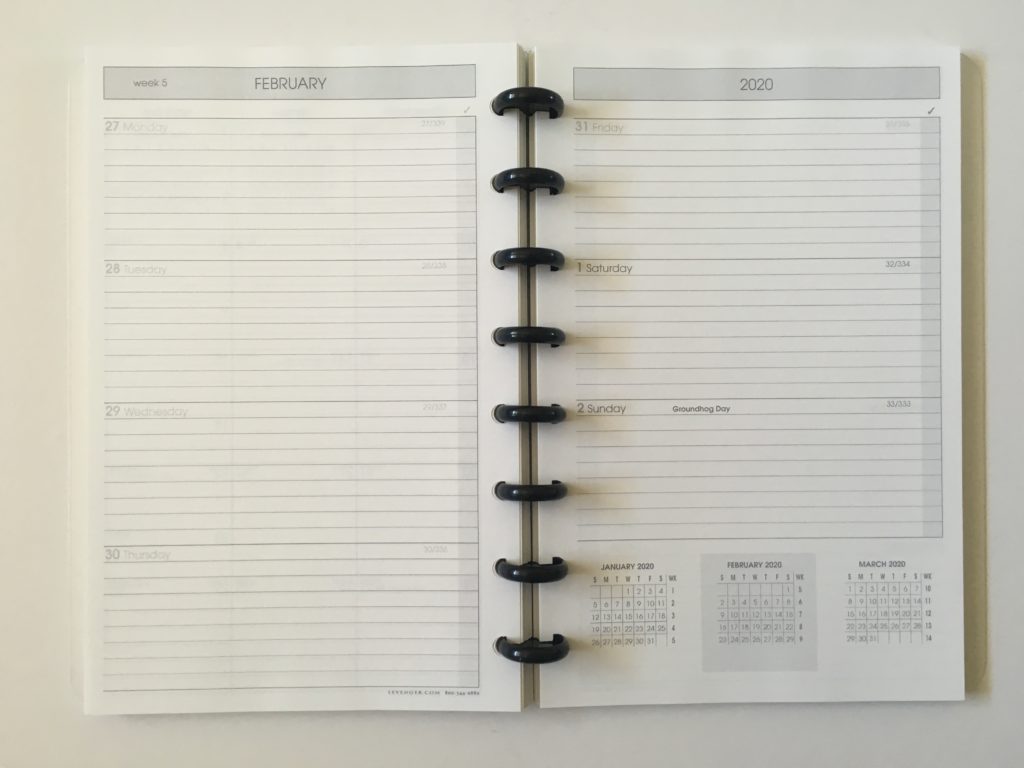

For example, one company may make their 8.5 x 11 planner with 6 rings, while another company makes theirs with 8 rings. It’s important to check the ring format because companies make various ring systems. You can choose daily, weekly, or monthly layouts, address sections, goal setting sections, expense trackers, and plain pages. Many companies that produce ring bound systems also sell lots of additional pages to make it customizable. If you don’t want an entire year in your planner, you can remove all but a few months for a much lighter planner. This style is popular because allows you to add or remove pages easily. Companies like Filofax made them the go-to planner for career-minded professionals. Ring bound is a style that has been around for ages. What I really love about these planners is the clean layout, quality of the paper, the gold edging, and additional pages to track website/passwords, birthdays and anniversaries, and other important information.

They have both book bound and spiral bound versions. This collection of streamlined planners makes it easy to track the busy schedules of your entire family. Here’s a link to check Erin Condren prices and styles. There are quite a few layout options as well as an interesting assortment of fun and colorful covers. You have to work within the pages provided.Įrin Condren creates a well known line of spiral planners. The only downside to spiral bound planners is that they are not customizable. Spiral bound is nice and easy to work in, because you have 360 degree turning of the pages. I always do a “layflat” test before buying a book bound planner. Each of these systems has their pros and cons.īook bound is beautiful and produces a gorgeous quality book you’ll want to keep for years, but unless it’s a Moleskine, most book bound planners don’t usually lay flat. It’s also important to consider how planners are bound: book bound, spiral bound, ring bound, and disc bound. When considering a size, ask yourself the following questions:ĭo you want something small and portable that you can take everywhere you go?ĭo you do most of your planning at your desk and don’t need to move it around?ĭo you like to use your planner for appointments only or do you like a lot of space to record lots of details?Īnswering these questions will help you determine what size planner will work best for you. It’s important to think about how you plan on using yours. Planners are available in sizes from small pocket size to larger desktop versions. It depends on the brand or type you buy that pre-determines what is included. They are readily available at office supply stores, stationery stores, books stores, craft chains, and of course, Amazon. Most often they come out at the beginning of a calendar year and are available in daily, weekly, monthly, or yearly views. Planners come in a wide variety of sizes and with pre-planned layouts. Let’s dive in and talk about the features and benefits of each. Should you go with a traditional planner or a bullet journal? If you answered YES to any (or all) of these, it’s probably time to look into a planning system that better suits your needs. When is it time to reevaluate your organizational system?ĭo you sit down at your desk and feeling disorganized and unprepared?ĭo you have to-do lists, paper scraps, and sticky notes scattered everywhere?ĭo you find it difficult to locate important information?ĭo you miss important meetings or appointments because you didn’t have it recorded properly?ĭo you have a hard time keeping track of your family’s schedule?ĭo you have separate notepads for meetings, school classes, calendars, grocery lists, etc.? Your goals, schedule, routine are constantly changing, so it is important to evaluate what is working or not working for you. In order to be successful, you need to find the RIGHT system to suit your needs at this point in your life. I’m guessing you are here because your current organizational system isn’t working for you. We’ll take a look at both and talk about the pros and cons of each. So, I thought I’d take some time to discuss the features and benefits of each so you can find out which is the best for you. I’m often asked which is best a planner or a bullet journal?

I’ve tried so many planners, agendas, diaries, note books, and bullet journals. Please see my full disclosure for more information. There’s just something about putting pen to paper that slows things down, allows me to be mindful, and enjoy the process of planning my day.

I love using paper for planning and journaling.


 0 kommentar(er)
0 kommentar(er)
